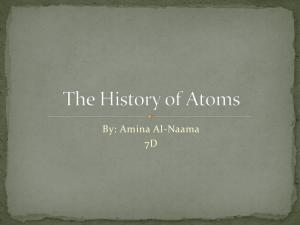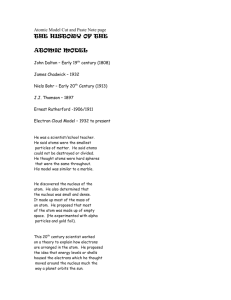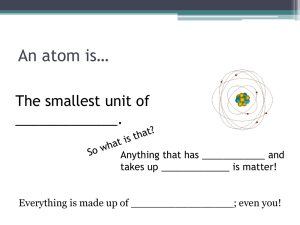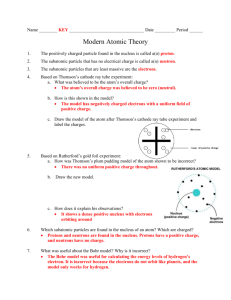What holds an atom together?
advertisement
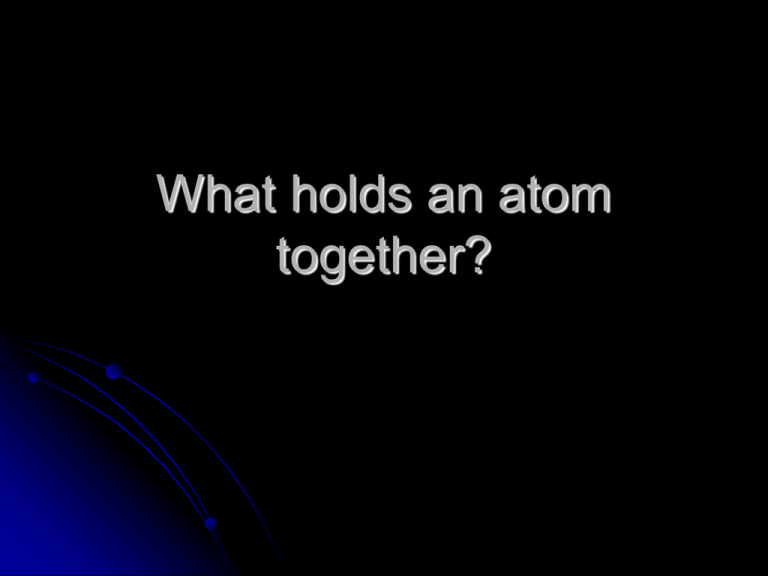
What holds an atom together? Subatomic Particles subatomic-lower (or smaller) than an atom Protons-positive particles Neutrons-neutral particles Electrons-negative particles Location of particles Protons and neutrons are in the nucleus (core) of the atom. electrons are buzzing around the nucleus in the electron cloud or shell. The nucleus makes up 99.99% of the mass of the atom. You compared to pocket lint The nucleus is 1/100,000 of the volume of an atom a marble compared to a football stadium Mass of particles Since subatomic particles are so small they cannot be measured in grams instead they are measured in atomic mass units or amu 1 amu = 1.61x10-24 g remember 1 g is about the mass of a paper clip Table of particles name symbol charge protons p+ location mass positive nucleus 1 amu neutrons no neutral electrons e- negative electron .0006 amu shell nucleus 1 amu Fundamental Forces in Nature Gravity- universal attraction of all objects to one another Electromagnetism- Attraction or repulsion based on charge or poles Strong Nuclear Force- Force holding the nucleus of an atom together Weak Nuclear Force- Force causing subatomic particles to change into one another (causing nuclear radiation) Quantum Forces Gravity is described by Einstein’s general relativity. General relativity and quantum mechanics contradict each other. We don’t discuss gravity at an atomic level, because it is not fully understood. We also won’t discuss the weak nuclear force at this point because it is responsible for breaking atoms apart, not holding it together. Quantum Quantum mechanics describe how forces and motion work at an atomic level. The word quantum is from the root “quanta-” meaning how much (quantity) Energy only comes out of an atom in discrete amounts (specific numerical amounts- little chunks) ~it works like getting $ change Say someone owes you $3.25 The only money you can get from them come in the discrete amounts of $1, 50¢, 25¢, 10¢, 5¢, or 1¢ How atoms release energy atoms can absorb energy causing electrons to “jump” to a state of higher energy. This is called an excited state Electrons will leave ground configuration (electron configurations we have been drawing), and move to higher energy positions When electrons return to ground state they release energy in discrete amounts. How do we know When atoms “drop” from an excited state back to ground they emit energy as light. Light refers to all of the electromagnetic spectrum, not just the colors we can see. Infrared, ultraviolet, radio waves, and microwaves are all types of light like Red, Orange, Yellow, Green, Blue, (Indigo) and Violet. All travel at c (the speed of light 3 x108 m/s) The difference between these is their frequency, wavelength, and energy. EM Spectrum /frequency Neils Bohr Bohr saw, when he dispersed (put it through a prism to separate it) light from a hydrogen light bulb, distinct bands of colors instead of a smooth transition. What you would expect What he actually saw Hydrogen light bulb A hydrogen light bulb works like a neon light. Electricity goes through the hydrogen gas. Hydrogen atoms jump to an excited state. When their electrons fall back to ground state, they give off energy as light. Since we only see bands of light (when dispersed), we know energy is coming out in discrete amounts, not a steady flow. Energy Levels From this, Bohr determined electrons were at certain energy levels from the nucleus.
